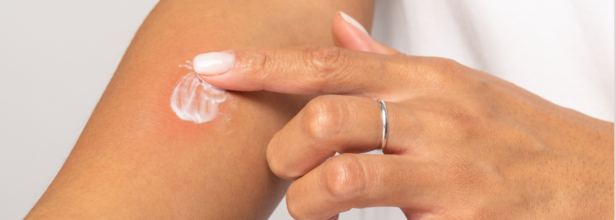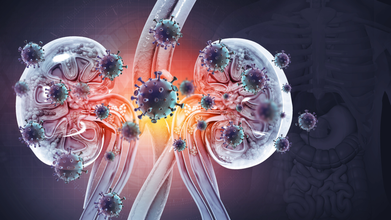- Health Conditions A-Z
- Health & Wellness
- Nutrition
- Fitness
- Health News
- Ayurveda
- Videos
- Medicine A-Z
- Parenting
6 Treatments To Get Rid Of Ringworms

Ringworm treatment
Ringworm is a common, highly contagious fungal infection and more easily managed than the name might suggest. Scientifically known as tinea corporis, this skin infection thrives in warm, moist environments but can occur in all climates. The good news? With the right treatments and hygiene practices, you can get rid of ringworm effectively and prevent its return.
Ringworm can be quite difficult at times, but with proper treatment options and hygiene practices, it becomes pretty manageable. Whether mild or persistent, acting fast with a proper treatment will surely help you get rid of the infection and make it not come back.
If you are unsure, see your healthcare provider to discuss stronger treatment options to ensure a speedy recovery. Keeping proactive will help you maintain this pesky fungal infection at bay and keep enjoying healthy, ringworm-free skin.
Ringworm is caused by fungi that normally live in our nails, skin, and hair. These fungi are generally benign but multiply when the environment is warm and humid.
You can get ringworm through:
- Direct skin-to-skin contact with an infected person.
- Pets, especially cats and dogs, and livestock like cows are common carriers.
- Shared towels, combs, clothes, or even contaminated surfaces can harbor the fungi.
- Walking barefoot or handling infected soil can lead to an infection.
Who Is at Risk?
Although anyone can get ringworm, some factors increase the susceptibility:
- Weakened immune system because of autoimmune diseases or diabetes.
- Warm, humid climates or activities that cause excessive sweating.
- Living in close contact with other people, such as shared housing, locker rooms, or military settings.
- Wearing tight clothing or not drying off well after bathing.
- Playing contact sports, such as wrestling or football.
Treatment of Ringworm
Ringworm treatment involves a combination of antifungal medication and good hygiene. Here's a step-by-step guide to manage the infection properly:
1. Topical Antifungal Creams, Lotions, or Powders
Most ringworm infections can be treated at home using OTC antifungal creams, lotions, or powders.
- Wipe the affected area clean and apply a thin layer of the medication. Extend application slightly beyond the rash to prevent spread.
- Apply twice daily for 2–4 weeks, or as directed, even after symptoms improve to ensure the fungus is eradicated.
2. Let the Rash Breathe
While it would seem intuitive to cover the rash, bandages can retain moisture and delay healing. Instead, use loose-fitting, light, breathable clothing to keep the area dry and prevent the spread.
3. Bathe bedding and clothes daily
Fungal spores can linger on bedding and clothing, prolonging the infection and risking reinfection. Wash your sheets, towels, and clothes daily using hot water and detergent. For added protection, include borax or bleach in the wash, which kills fungal spores.
4. Change Wet Socks and Underwear
Ringworm thrives on moist environments, and so you can say sweaty socks and underwear are a culprit in the prolongation of an infection. Keep these places dry and change clothes as frequently as possible if you happen to sweat during the day.
5. Utilize Antifungal Shampoo for Scalp Infection
If ringworm starts appearing on your scalp where you experience hair loss, dandruff, or boils, an antifungal shampoo will help you to get rid of this. These shampoos contain the following:
- Ketoconazole
- Selenium sulfide
- Pyrithione zinc
Follow the product's instructions and use regularly until the infection clears.
6. Consider Prescription Antifungals
If OTC treatments aren't effective after two weeks, see a healthcare provider. Prescription-strength topical creams or oral antifungal medications may be needed, especially for severe or widespread infections.
Hygienic Practices for Speedy Recovery
Cleanliness plays a vital role in treating and preventing ringworm:
- Clean frequently touched surfaces and personal belongings.
- Bathe your pet bedding if your pet is infected.
- Do not share personal items such as towels, combs, or clothing.
- For athlete's foot, disinfect or replace shoes to remove fungal spores.
Preventing Future Ringworm Infections
Prevention is the best way to prevent recurring infections:
- Keep yourself clean and dry your skin completely after bathing, especially in areas that sweat easily.
- Avoid walking barefoot in public showers or locker rooms.
- Treat infected pets promptly and wash your hands after handling animals.
- Wear breathable fabrics to minimize sweat buildup.
Why Women Love To Take Very Hot Shower, According To Doctor

Credits: iStock
For years, people have joked about how women seem to enjoy showers that could probably cook noodles. If you are someone who loves cranking up the water temperature until the bathroom looks like a steam room, you may have wondered whether there is an actual reason behind it. According to UK surgeon and content creator Dr Karan Rajan, the answer lies in biology. Women are not simply choosing scalding showers for fun. Their bodies are wired differently, and that affects how they experience temperature.
Higher Core Body Temperature
Dr Rajan explains that, on average, women have a slightly higher core body temperature than men. It might sound like this would keep them warmer, but in reality, it does the opposite. When the core is warm but the surrounding environment is cool, that contrast makes cold air feel even colder. So a mildly chilly room may feel more uncomfortable for women, leading them to turn to hotter showers to compensate.
This idea has gone viral online. In a popular TikTok clip, creator couple Micah and Sarah joked about preparing for a shared shower. Micah pretended to train for the extreme heat by dipping his hand in boiling water. The internet quickly chimed in with comments like “My husband says I am training for hell” and “He calls it lobster time”. The jokes were relatable because many couples experience this temperature divide, but not many knew the science behind it until now.
Hormones Add to the Chill
Hormones play a major role too. Estrogen affects blood flow to the extremities, which includes hands, feet and even earlobes. Research shows that women’s extremities can be up to three degrees colder than men’s. Dr Rajan points out that this becomes more noticeable during ovulation when estrogen levels peak. Women on hormonal birth control may also experience increased sensitivity because estrogen stays higher for longer periods.
So even when the core stays warm, the toes and fingers may feel unusually cold. A very warm shower becomes a quick and comforting fix for this temperature imbalance.
Lower Metabolic Rates
Another biological factor is metabolic rate. Women generally have a lower resting metabolic rate than men, meaning they produce less body heat throughout the day. This naturally makes them feel colder and more drawn to hotter water while bathing. Women also tend to have more body fat and less muscle mass, which influences how the body responds to temperature changes.
What Doctors Say
Australian GP Dr Jasmina Dedic Hagan supports these findings, as reported in Body and Soul. She explains that women typically have warmer cores, cooler skin, and a higher layer of insulating fat around the body. On top of that, they have reduced circulation in the extremities because the body prioritises keeping reproductive organs warm. With less muscle mass, the body’s heat-producing brown fat does not function in quite the same way as it does in men.
So Is It Just Preference?
Not entirely. While some women truly enjoy the sensation of a very hot shower, much of it is tied to biology. From hormones to metabolism to circulation, several factors work together to make warmer showers feel soothing and sometimes even necessary. So the next time someone teases you about loving lava-level water, you can tell them it is simply science at work.
Should I Take A Shower When I'm Sick?

Credits: iStock
When you are burning up, even a simple shower can feel confusing. Should you cool your body quickly with cold water or soothe your aches with something warm? Fever is a natural defense mechanism, but the symptoms it brings can make you feel miserable. The right water temperature can help ease discomfort and support your recovery.
Below is a simple breakdown of how fever affects your body, followed by practical shower tips and additional ways to safely bring your temperature down.
How Fever Resets Your Body’s Thermostat
During an infection, your immune system releases chemicals called pyrogens. These signals tell the hypothalamus, which is your internal thermostat, to raise your core temperature. The added heat slows the growth of certain viruses and bacteria and helps immune cells work more efficiently.
This temperature rise is why you feel:
- Chills as your body works to reach the new set point
- Sweating when the fever begins to settle
- Faster heart rate and quicker breathing, which increase fluid loss
Knowing this matters because water that is too cold can trigger intense shivering, which drives your temperature higher. Water that is too hot can widen your blood vessels and increase sweating, which may worsen dehydration.
Cold, Lukewarm, or Hot: Which Shower Helps Most?
Each water temperature works differently with a fever. Understanding these differences helps you choose what your body needs at that moment.
Cold showers cool your skin quickly. They may feel refreshing if you are overheated, but they often trigger shivering. That shivering can raise your core temperature and is especially risky in children.
Lukewarm or tepid showers are the safest choice for most people with fever. This temperature allows gentle heat loss through the skin without causing shivering. It helps you cool down gradually while keeping your body comfortable.
Warm or hot showers can help relieve muscle aches or sinus congestion, especially for adults. However, they can increase sweating and may slightly raise your temperature. Avoid them if you are already overheated or dehydrated.
Simple Shower Tips When You Have a Fever
- Start with lukewarm water to safely reduce temperature and ease discomfort.
- If you feel flushed and sweaty, splash cold water only on pulse points such as the wrists and neck.
- Use warm showers only for congestion relief and follow up with hydration and light clothing.
- If you feel dizzy, sit on a chair outside the shower and let steam fill the bathroom while you take a gentle sponge bath.
Other Safe Ways to Bring Down a Fever
Rest
Your body is already working hard to fight the infection. Light activity can raise your temperature further, so give yourself time to rest and recover.
Stay Hydrated
Fever increases the risk of dehydration, especially if you have vomiting or a poor appetite. Sip water, oral rehydration solutions, or electrolyte drinks. Chilled fluids can also help lower your temperature.
Stay Cool
Keep your room slightly cool and wear loose, breathable clothing. If you have chills, use a light blanket but avoid overheating. You can place a cool cloth on your forehead or under the arms for short intervals.
Medication
Over the counter fever reducers like acetaminophen and ibuprofen can safely lower fever. Always follow dosage guidelines. Avoid aspirin in children because it can lead to Reye's syndrome.
What Not to Do
- Do not take cold showers or ice baths because they trigger shivering and can raise your temperature.
- Avoid alcohol rubs since the alcohol can be absorbed through the skin.
- Do not take extra doses of fever medicine thinking it will work faster.
- Always read medication labels carefully to avoid accidental overdosing.
Is There A Link Between Your Kidney Health And Other Chronic Diseases? Lancet Study Says Yes

Credits: iStock
Turns out, kidney disease is not just a ‘kidney’ problem anymore, it can, in fact, affect other organs, and could even be linked to other chronic conditions, revealed a recent study.
In the US, more than 1 in 7 adults are affected by chronic kidney disease or (CKD). This means that 35.5 million Americans are affected by it, and what makes it worse is that 9 out of 10 people do not even know they have CKD, says the Centers for Disease Control and Prevention (CDC). Amid all these numbers thrown on to, something more concerning lies. A recent Lancet study shows a link between the rise in CKD and other chronic diseases. We are talking about chronic conditions like diabetes, high blood pressure, and obesity.
So, What Does The Study Say?
The researcher saw that 14 percent of adults who are over the age 20 or older, which makes 788 million Americans who had CKD in 2022. The biggest problem is not the disease itself, but the unawareness. Doctors, experts, and researchers from time and again have pointed out how kidney disease is often asymptomatic, this is why it is ignored until it becomes advanced. However, at that point the patients could already need dialysis or even an organ transplant. This gap in early diagnosis and treatment is what has made CKD the ninth leading reason of death, worldwide.
When you kidney functions naturally, it works as the powerhouse of filtration. A pair of healthy kidneys are able to filter and process more than 150 liters of fluid from the blood. These organs are also responsible for filtering out the waste and toxins through your urine. Not just that, but your kidneys also help in red blood cells production that keeps you healthy. When all of that does not happen, it can eventually impact every other organ in your body.
Like they say, everything is connected, and it surely is. For instance, somewhere around 20% of the blood that your heart pumps goes to your kidneys. If someone has diabetes and high blood pressure, it could damage the blood vessels and lead to protein in the urine and a slower filtration rate. It can then lead to other chronic infections, autoimmune disorders, and even genetic variants.
Kidney-Body Relation
If you leave your kidney disease untreated, it could lead to kidney failure. This is when you would be more in need of dialysis or a transplant. Doctors have pointed out that most people do not die of chronic kidney disease, rather it impacts their quality of life, worsening their cardiovascular conditions. It can lead to complications like a heart attack, a stroke, or a heart failure.
How Does This Happen?
People who have kidney diseases are at an increased risk for high blood pressure. Due to hurdles in the process of filtration, plaque build ups and hardens the arteries. This in return increases stress on the heart. In fact, the American Heart Association also defined the link between kidney and heart as 'cardiovascular-kidney metabolic syndrome'. This defines a health disorder that is a condition of the overlap of obesity, chronic kidney disease and cardiovascular diseases.
The bleed out of CKD is not just limited to your heart. The National Institute of Health, US points out that along with heart complications and high blood pressure, CKD could also lead to anemia, mineral and bone disorder, metabolic acidosis, malnutrition, and electrolyte imbalances in the blood.
So, What Is The Best Way To Keep Yourself Safe?
The first way is to note any symptoms and get yourself diagnosed. Look for signs like loss of appetite, unexplained nausea or vomiting. Do you feel tired often? Are you having trouble concentrating? Is there any change in how often you go pee?
Other symptoms like a change in your urine color or texture, or feeling itchy or dry, muscle cramps, unexplained weight loss or skin conditions could also signal towards kidney diseases.
However, not always does CKD show symptoms, experts suggest that to be one step ahead, it is important to undergo regular health checkups, including blood culture. General guidelines usually point towards getting a blood test done every 3 to 6 months. For someone with high blood pressure, diabetes or any other disease, the current guidelines say that those people should get regular blood and urine tests to screen for kidney disease. But what really happens is that though these tests exist, they are still used far too little. Doctors point out that many patients skip them because collecting a urine sample feels inconvenient, and overall awareness about kidney disease remains low. As a result, research shows that only about 35 percent of people with diabetes, and just 4 percent of those with high blood pressure, actually end up getting the recommended urine screening.
A ray of hope is that there are now several effective tools to slow the progression of kidney disease. Along with traditional options like ACE inhibitors, newer classes of medications including certain heart failure drugs and GLP-1 drugs. These medicines have shown to help protect kidney function. Although these newer treatments are not widely used yet, their adoption is steadily increasing.
What is important to remember is to also always consult your GP to ensure all preventative measures are followed carefully.
© 2024 Bennett, Coleman & Company Limited

